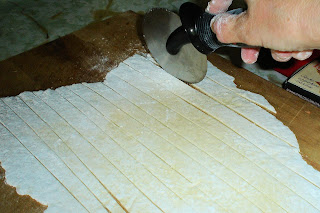I can find the "noodles" recipe in my favourite Mennonite cookbook by touch. The page is gritty with flour. Noodle making is a floury undertaking.
I modified this recipe quite a bit as I used it, as ingredients have changed a bit since the 1950s, when it was first written. For one, eggs aren't usually as fresh or as big as farm eggs used to be. Standardization of breeding has changed that. I wonder, too, if flour has changed a bit, with different wheat varieties - there are fewer heirloom types commercially available - and a better drying process.
Noodles are easy but time consuming. It helps to have someone else to aid with cutting and hanging the noodles to dry. I don't recommend doubling the recipe unless there is someone else to spell with the rolling.
The equipment: Mixing bowl, measuring cup, heavy wooden spoon or steel mixing spoon, rolling pin (mine is marble), counter top or pastry board, sharp knife or rotary pizza cutter, floured tea towels or a folding clothes drying rack.
The ingredients: 2 cups flour, 2 whole eggs or 4 yolks, a pinch of salt, 1/2 cup or so of cold water.
Sprinkle the salt into the flour in the mixing bowl, lightly toss with your hands. Make a little well in the middle of the flour, add the eggs, muddle a little, then blend into the flour, adding the water as needed to make a dough that holds together and doesn't leave a lot of crumbs in the bottom.
Turn the dough out onto a floured board or counter top, and knead lightly until it is smooth and all the crumbly bits are worked in. Divide into four balls, add roll out one ball as thin as possible without tearing it. (Here is where a heavy marble pin really helps.) You are aiming for a rough rectangle in shape. You will never get it commercial egg noodle thin unless you have a pasta machine to roll it.
Put the dough sheet on a cutting board, and using a very sharp pointed knife, or even easier, a sharp pizza cutter, cut the rough rectangle the long way into strips about 1/4" wide, or whatever size you want. I toss the ragged edges aside to reroll.
Hang the cut strips on a drying rack - I use my wooden laundry rack, or lay them out on a floured tea (linen) towel or even a clean sheet if you can't improvise a drying rack. Some Mennonite women hang them on broomsticks laid across the backs of chairs. You can hang towels or sheets over the noodles to keep them clean, but it does slow down the drying. I always put a large towel under the drying rack because I will drop some of the noodles, without fail.
Roll and cut the rest of the noodle dough the same way. Leave it to dry at least a couple of hours. Traditionally, noodles were made in the morning for the evening meal. If there are more noodles than you wish to cook at once, let the rest dry overnight and store them in a canister or jar.
To cook: Get the rest of the meal prepared and hold it warm. Bring a pot of water to a boil, throw in some noodles, and cook at boiling for about five minutes. Test a piece for doneness. When it is cooked to your satisfaction, drain in a colander, and wither serve immediately or use in another dish. If you want to keep noodles in the refrigerator after boiling, toss them with olive oil or a bit of butter.
Serve the noodles dressed with butter and pepper, or with gravy. They are also really good with some fresh grated mild cheese, a little olive oil, and some fresh herbs. They can be the platform for Italian style tomato sauces, as well.
My mother would make them evenings my father was working, and we would have them in tomato soup garnished with bacon bits. We still eat them that way. It is a delicious light supper. Use any favourite canned or tetra pak tomato soup, or make your own by simmering tomato juice until it is reduced in volume by about 25%, then add a spoonful or so of sugar, a pinch of salt, and celery seed or other herbs. The bacon I use is smoked locally and is as dense as ham. I don't buy much of it because I use it mainly as a garnish or flavouring. I add fresh herbs to my soup, since I have a miniature herb garden just outside the door. Basil, chives and parsley are good.




Yummy!
ReplyDelete